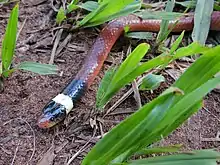| Phalotris | |
|---|---|
 | |
| Phalotris matogrossensis | |
| Scientific classification | |
| Domain: | Eukaryota |
| Kingdom: | Animalia |
| Phylum: | Chordata |
| Class: | Reptilia |
| Order: | Squamata |
| Suborder: | Serpentes |
| Family: | Colubridae |
| Subfamily: | Dipsadinae |
| Genus: | Phalotris Cope, 1862 |
Phalotris is a genus of snakes of the subfamily Dipsadinae. All species of the genus Phalotris are found in South America.[1] The specific name, mertensi, is in honor of German herpetologist Robert Mertens.[2] The specific name, normanscotti, is in honor of Norman Scott, Jr., in recognition of his contribution to the knowledge of the herpetofauna of Paraguay.[3]
Venom
The venom of this genus was poorly characterized, due to the low amount produced by Colubridae, a more detailed characterization of particularly interesting proteins could only be viable by obtaining recombinant proteins, but there is a report of an accident by a Phalotris, which resulted in headache, local and oral mucosa hemorrhage, edema and renal failure. Another accident report occurred with a 37-year-old biologist, whose symptoms were immediate local pain, bleeding and edema, a few hours later there was headache, systemic hemorrhage, fever, myalgia and dark urine. A study of the venom of Phalotris mertensi showed a myotoxic action 3 times greater than Bothrops jararaca.[4][5]
Species
The following 19 species are recognized as being valid.[1]
- Phalotris bilineatus (Duméril, Bibron, G. & Duméril, 1854) - Dumeril's diadem snake
- Phalotris concolor Ferrarezzi, 1993
- Phalotris cuyanus (Cei, 1984)
- Phalotris illustrator Scrocchi, Giraudo, & Nenda, 2022
- Phalotris labiomaculatus de Lema, 2002
- Phalotris lativittatus Ferrarezzi, 1993
- Phalotris lemniscatus (A.M.C. Duméril, Bibron & A.H.A. Duméril, 1854) - Duméril's diadem snake, Pampeana black headed snake
- Phalotris matogrossensis de Lema, D'Agostini & Cappellari, 2005 - Mato Grosso burrowing snake
- Phalotris mertensi (Hoge, 1955)
- Phalotris multipunctatus Puorto & Ferrarezzi, 1993
- Phalotris nasutus (Gomes, 1915)
- Phalotris nigrilatus Ferrarezzi, 1993
- Phalotris normanscotti Cabral & Cacciali, 2015 - Chaco burrowing snake
- Phalotris reticulatus (W. Peters, 1860)
- Phalotris sansebastiani Jansen & G. Köhler, 2008
- Phalotris shawnella Smith, Brouard & Cacciali, 2022[6]
- Phalotris spegazzinii (Boulenger, 1913)
- Phalotris suspectus (Amaral, 1924) - Dumeril's diadem snake
- Phalotris tricolor (A.M.C. Duméril, Bibron & A.H.A. Duméril, 1854) - tricolored burrowing snake
Nota bene: A binomial authority in parentheses indicates that the species was originally described in a genus other than Phalotris.
References
- 1 2 Genus Phalotris at The Reptile Database.
- ↑ Beolens, Bo; Watkins, Michael; Grayson, Michael (2011). The Eponym Dictionary of Reptiles. Baltimore: Johns Hopkins University Press. xiii + 296 pp. ISBN 978-1-4214-0135-5. (Phalotris mertensi, p. 176).
- ↑ "Phalotris normanscotti ". The Reptile Database. www.reptile-database.org.
- ↑ "O27-Envenomation by Phalotris trilineatus in Rio Grande do Sul, Brazil. A case report". www.jvat.org.br. Retrieved 2021-10-03.
- ↑ "Trends in the Evolution of Snake Toxins Underscored by an Integrative Omics Approach to Profile the Venom of the Colubrid Phalotris mertensi".
- ↑ Smith, Paul; Brouard, Jean-Paul; Cacciali, Pier (2022-03-07). "A new species of Phalotris (Serpentes, Colubridae, Elapomorphini) from Paraguay". Zoosystematics and Evolution. 98 (1): 77–85. doi:10.3897/zse.98.61064. Retrieved 2022-05-23.
Further reading
- Cope ED (1862). "Observations upon certain Cyprinoid fish in Pennsylvania; on Elapomorphus, Sympholis, and Coniophanes ". Proc. Acad. Nat. Sci. Philadelphia 13: 522–524. (Phalotris, new genus, p. 524).
- Cacciali, P., Mee, G., Plettenberg Laing, A., Krause, D., Mclaughlin, C., Montgomery, R. and Smith, P. (2020). "Morphological Re-Examination of the Endemic Paraguayan Snake Phalotris nigrilatus Ferrarezzi, 1993 (Serpentes: Colubridae: Elapomorphini), with Notes on Its Ecology and Conservation Status." Current Herpetology, 39(1), 28–37. www.herpco.com